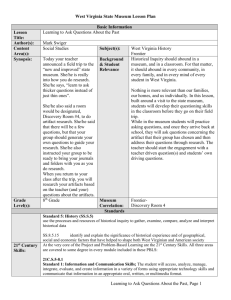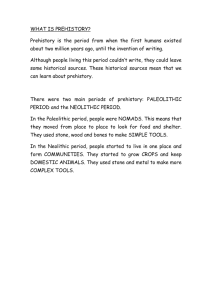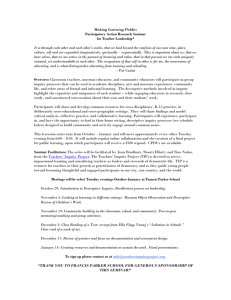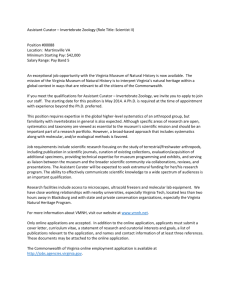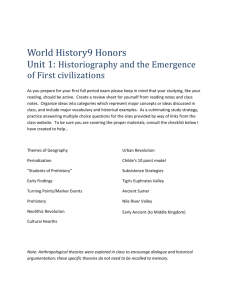Time Warp From Frontier to Prehistory Lesson
advertisement
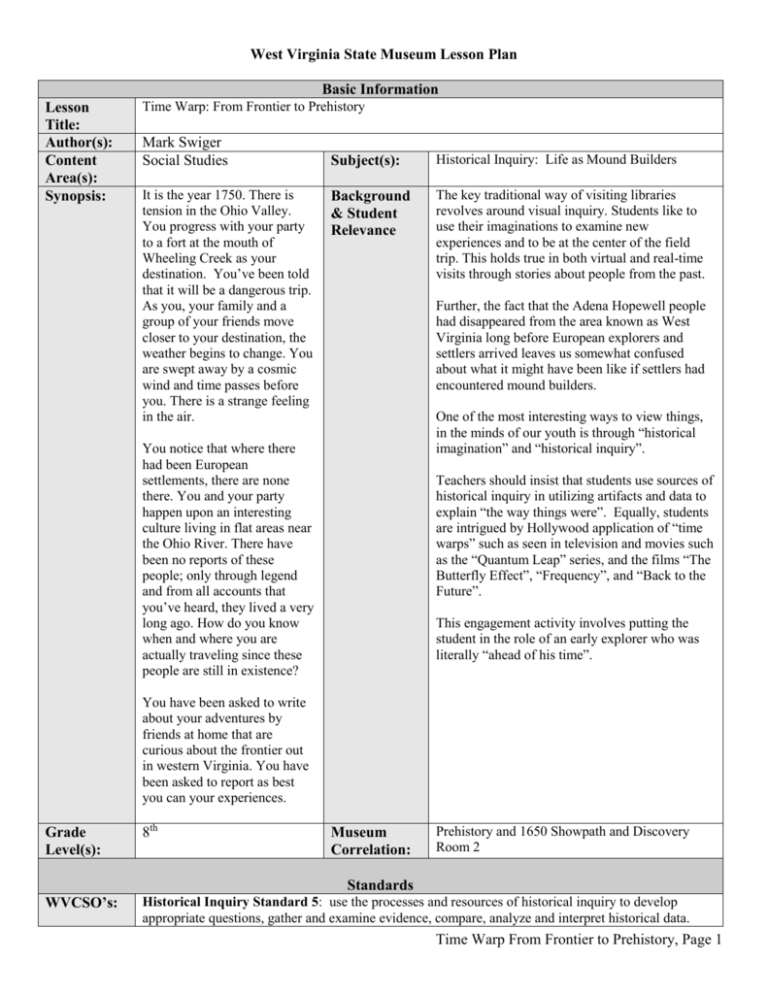
West Virginia State Museum Lesson Plan Basic Information Lesson Title: Author(s): Content Area(s): Synopsis: Time Warp: From Frontier to Prehistory Mark Swiger Social Studies It is the year 1750. There is tension in the Ohio Valley. You progress with your party to a fort at the mouth of Wheeling Creek as your destination. You’ve been told that it will be a dangerous trip. As you, your family and a group of your friends move closer to your destination, the weather begins to change. You are swept away by a cosmic wind and time passes before you. There is a strange feeling in the air. Subject(s): Historical Inquiry: Life as Mound Builders Background & Student Relevance The key traditional way of visiting libraries revolves around visual inquiry. Students like to use their imaginations to examine new experiences and to be at the center of the field trip. This holds true in both virtual and real-time visits through stories about people from the past. Further, the fact that the Adena Hopewell people had disappeared from the area known as West Virginia long before European explorers and settlers arrived leaves us somewhat confused about what it might have been like if settlers had encountered mound builders. One of the most interesting ways to view things, in the minds of our youth is through “historical imagination” and “historical inquiry”. You notice that where there had been European settlements, there are none there. You and your party happen upon an interesting culture living in flat areas near the Ohio River. There have been no reports of these people; only through legend and from all accounts that you’ve heard, they lived a very long ago. How do you know when and where you are actually traveling since these people are still in existence? Teachers should insist that students use sources of historical inquiry in utilizing artifacts and data to explain “the way things were”. Equally, students are intrigued by Hollywood application of “time warps” such as seen in television and movies such as the “Quantum Leap” series, and the films “The Butterfly Effect”, “Frequency”, and “Back to the Future”. This engagement activity involves putting the student in the role of an early explorer who was literally “ahead of his time”. You have been asked to write about your adventures by friends at home that are curious about the frontier out in western Virginia. You have been asked to report as best you can your experiences. Grade Level(s): 8th WVCSO’s: Historical Inquiry Standard 5: use the processes and resources of historical inquiry to develop appropriate questions, gather and examine evidence, compare, analyze and interpret historical data. Museum Correlation: Prehistory and 1650 Showpath and Discovery Room 2 Standards Time Warp From Frontier to Prehistory, Page 1 West Virginia State Museum Lesson Plan SS.O.8.5.3 point out characteristics of various Native American cultures in West Virginia from the pre-Columbian period to the arrival of Europeans. SS.O.8.5.5. 21st Century Skills: compare and contrast the motives, incentives and settlement patterns of the French and English explorers and settlers on the western frontier. At the very core of the Project and Problem-Based Learning are the 21st Century Skills. All three areas are covered to some degree in every module included in these PBLS: 21C.S.5-8.1 Standard 1: Information and Communication Skills; The student will access, analyze, manage, integrate, evaluate, and create information in a variety of forms using appropriate technology skills and communicate that information in an appropriate oral, written, or multimedia format. 21C.S.5-8.2 Standard 2: Thinking and Reasoning Skills; The student will demonstrate the ability to explore and develop new ideas, to intentionally apply sound reasoning processes and to frame, analyze and solve complex problems using appropriate technology tools. 21C.S.5-8.3 Standard 3: Personal and Workplace Skills; The student will exhibit leadership, ethical behavior, respect for others; accept responsibility for personal actions considering the impact on others; take the initiative to plan and execute tasks; and interact productively as a member of a group. Implementation Plan Essential Question: How did Pre-Columbian Native Americans live in West Virginia before the arrival of European settlers? Pre-Visit: Distribute folders with Individual Project Checklists taped to the front. This is where they will save their data and notes. Have students read this primary source document from Meriwether Lewis’ journal describing the Grave Creek Mound in 1803. This short reading could provide an experience where students could gain prior knowledge before they visit. http://www.wvculture.org/history/nativeamericans/gcmoundlewis.html . After students read this primary source document, have them examine the Lewis and Clark expedition to find out more information. Other sites for reading about Native Americans can be found at the West Virginia Archives site at http://www.wvculture.org/history/nativeamericans.html. Teachers may give as many of these archives sites as needed. Primary source documents help place students back in time by analyzing data. During Visit: Because little is known about Mound builders, other than what evidence was left at the village sites, students may have to use mental imagery to think about how much time passed between the coal forest period and early settlers. Have students read artifact descriptions and come up with their own interest inventory and then describing for a teammate how that artifact might have been used by early Native Americans to make their lives better. Students should start a journal for their next project at this point. That journal is to be placed in their individual project folder. If text devices are available in the museum for text messaging, that would be an option in place Time Warp From Frontier to Prehistory, Page 2 West Virginia State Museum Lesson Plan of the writing in a folder and could be transferred at a later time. Post Visit PBL: Project Based Learning requires the same process each time it is utilized. Refer to curriculum overview at the beginning of this guide for more information and to see a detailed process for implementation. Upon your return from either a virtual or actual visit to the museum, follow these steps: Preparation for PBL is the most time consuming part of the teacher’s role. Once students are engaged and you’ve distributed rubrics, project checklists, scenarios, project ideas, and as well as Internet resources, the teacher becomes facilitator. Put students into groups that you know will work well within your classroom. It is recommended that you place the project checklist form on student folders so that individual assessment can take place. On that sheet students will self-assess and the teacher assesses student checklist and packet contents. Individual packets should be turned in before group projects are assessed so that the teacher can see who has been contributing. This can be done through journaling in the folders. Students, in their groups, will then go into the PBL Process: Project-Based Learning Process (Following the chart, look for the KWHL chart and directions on how to complete it based on this step-bystep process.) 1. Read and discuss the scenario and driving question together. Both are somewhat tied to the content standard in the lesson plan. The situation described in the scenario should be understood by all members of the class. After reading the scenario on the screen, if projected and on the paper if used as a handout, students will them break into small groups to begin to brainstorm. 2. Brainstorm known facts on the KWHL Chart. Students will list what they bring to the situation, given materials presented in the scenario and background statement on the KWHL concept map, into any of a number of graphic organizer software templates or on a handout. All students bring something special to the group. During this process, it is encouraged to list as many things as people know about the situation and the driving question. 3. Develop a problem statement. After careful review of the scenario and driving question. Student groups should write a brief statement about what it is they are attempting to do. All groups will interpret this differently. Clues to help construct this statement are embedded in the scenario and driving question, along with the mixture of “knowns”. As new information is found, this statement will change. It is encouraged to edit, revise, renew the problem statement as many times as is needed to come up with a solution. 4. Brainstorm what is needed to be known in order to solve the problem on the KWHL Chart. List what is needed to be known in question form in order to solve the problem on the concept map. At this point each member should identify a role to play and gather information on the topics on the list in order to move forward. It is encouraged to revisit the problem statement in order to reaffirm that the process should move forward at this point. Time Warp From Frontier to Prehistory, Page 3 West Virginia State Museum Lesson Plan 5. List possible solutions. Information gathering continues. If time permits, consulting outside sources, investigating other options, etc. may be pursued. The teacher has final input as to how much time is allowed. PBL can take a few days to a couple of weeks depending on how integral a teacher wants to be. It is recommended that the teacher finds power standards in order to justify more time to deal with this project/problem. 6. Revisiting Solutions. As time permits, the group may entertain revisiting their problem, view optional alternatives to the ones examined, or move toward reporting to the group. 7. Students offer solutions through Culminating Products. These can be websites, presentations, or movies from Movie Maker to name a few options. Individual packets should be evaluated before team products are presented so that the teacher can see if certain groups need more time based on individual students not completing tasks, or other issues arise. Report to the whole group an action plan that seems viable given all the options entertained by the group. It is encouraged to present in ways that show uniqueness, but are encouraged to refer to the teacher rubric. Product Description Every teacher has their preference in regard to assignments, but it is recommended that you allow students to guide their own learning through producing culminating projects. You should use formative assessment strategies such as periodic checklists, rubrics, and other performance based assessments throughout the project. It is highly recommended to keep the projects cooperative and collaborative. Sample charts and rubrics are included. Students should produce the following items both individually and as a group: Concept Maps Individual Portfolio folders that includes a journal Knowledge Maps (KWHL Chart) Additional reflection journals, writing projects within the project. Group presentations options are: PowerPoint Concept Maps Windows Movie Maker / iMovies Students may wish to write and perform songs, lyrics, and other projects that reflect a great understanding of the concepts in their problem. Material’s List Time Warp From Frontier to Prehistory, Page 4 West Virginia State Museum Lesson Plan One folder with pockets for each student Internet access Presentation Software Concept Mapping software (some free versions are available) Cheap folders for keeping journals and notes Posters in addition to presentations Digital cameras, flip cameras, camcorders can be utilized Assessment Time Warp From Frontier to Prehistory, Page 5 West Virginia State Museum Lesson Plan PBL Rubric Criteria Historical Inquiry Content Drawing Conclusions Cooperative Learning Product 21st Century Skills 4 The student demonstrates a thorough and effective application of the processes and resources of historical inquiry to develop appropriate questions, gather and examine evidence, compare, analyze and interpret historical data. 3 The student demonstrates consistent and accurate application of the processes and resources of historical inquiry to develop appropriate questions, gather and examine evidence, compare, analyze and interpret historical data. 2 The student demonstrates basic but inconsistent application of the processes and resources of historical inquiry to develop appropriate questions, gather and examine evidence, compare, analyze and interpret historical data. 1 The student demonstrates fragmented and incomplete application of the processes and resources of historical inquiry to develop appropriate questions, gather and examine evidence, compare, analyze and interpret historical data. Draws a conclusion that is supported by the data and gives supporting evidence for the conclusion Draws a conclusion that is supported by data, but fails to show any evidence for the conclusion Draws a conclusion that is not supported by data Fails to reach a conclusion, but turns in work The student actively listens to and values the opinion of others The student actively listens to but it is not evident that he/she values the opinion of others The student listens to but does not value the opinion of others. OR The student values the opinion of others but does not listen to them The student does not listen to and does not value the opinion of others, but turns in work The product shows evidence that the student reached valid conclusions based on data analysis and displayed the results of the analysis in appropriate formats The product shows evidence that the student reached valid conclusions based on data analysis but displayed the results of the analysis in inappropriate formats The product shows evidence that the student reached conclusions not based on data analysis and displayed the results of the analysis in appropriate formats. OR The product shows evidence that the student reached valid conclusions based on data analysis but lacked evidence of the analysis The product shows no evidence of analysis, but turns in work Communication, Critical Thinking, and Workplace skills were understood and applied at an exemplary level at all points in the group problem-solving process. Most of the Communication, Critical Thinking, and Workplace skills were understood and applied at acceptable levels at all points in the group problem-solving process. Some of the Communication, Critical Thinking, and Workplace skills were understood and applied at times during the problemsolving process. Few to none of the Communication, Critical Thinking, and Workplace skills were understood and applied during the group problem-solving process. Time Warp From Frontier to Prehistory, Page 6 West Virginia State Museum Lesson Plan Name__________________________ Project_________________________ Team Members in your group _________________________________________________________________________________________ ___________________________________________________________________ Project Checklist for PBL Lessons *Place the date that the task was completed or covered in the space in front of the task. All members of each group are responsible for keeping a checklist on the front of your folder. __________Read Scenario Driving Question __________Recorded Daily Discussions in Notes __________Worked on Concept Mapping Activity __________Develop a Problem Statement __________Completed Concept Map __________Role Play Various Groups in the Scenario __________Revisit and Revise the Problem Statement __________Produce Portfolio Project __________Present Findings through Presentation __________Turn in Completed Project ___________Student Self-Assessment Comments:____________________________________________________ ___________Teacher Assessment/Grade Comments:____________________________________________________ Technology Integration Students should be allowed to be as creative as they can be in presenting their findings. Project Based and Problem Based Learning work best in technology rich environments. Additional Notes Time Warp From Frontier to Prehistory, Page 7
